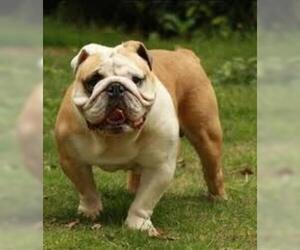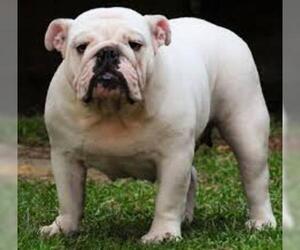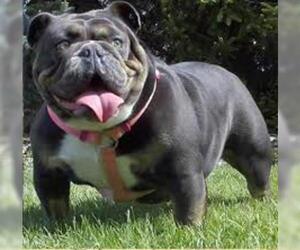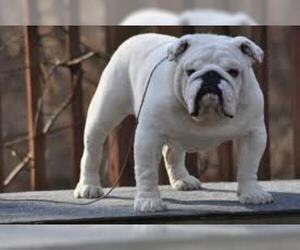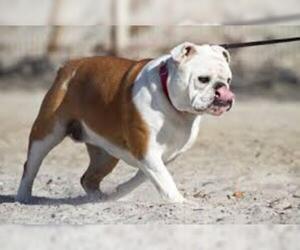
All about Bulldog dog breed
A.K.A. :English Bulldog, British Bulldog, Churchill Dog, Bully, Bully Dog, Gentle Bully, EB, Bulldogge, Royal Bulldog, UK Bully, Wrinkle Pup, Flatface Bully, Brit Bully, Bulldog Companion, Bulldogger, Lowrider Pup
Size
Grooming requirements
Exercise requirements
Good with other dogs
Watchdog ability
Energetic
Training requirements
Playful
Affectionate
Good with other pets
Good with children
Good with strangers
Winter
Summer
Healthiness
Protective
Life Span
| Pure Breeds | Member |
| Breeds A - Z | B |
| Breeds by Group | Flock Guards & Mastiffs Non-Sporting |
| Breeds by Trait | Good With Kids Low Shedding |
| Overview: | The Bulldog, often recognized by its distinctive pushed-in face and sturdy build, is a beloved breed with a rich history rooted in England. Originally bred for bull-baiting, their temperament has evolved significantly, making them gentle, affectionate companions today. Physically, Bulldogs are medium-sized, characterized by their broad shoulders, short legs, and loose, wrinkled skin. Their short coat typically comes in various colors and patterns. Despite their somewhat imposing appearance, Bulldogs possess a surprisingly sweet and docile nature, making them excellent family pets and remarkably well-suited for apartment living due to their lower energy levels. However, prospective owners should be aware of common health concerns, including brachycephalic airway syndrome, hip and elbow dysplasia, and skin fold dermatitis, which necessitate regular veterinary care and attention to their unique needs. Their calm disposition and moderate exercise requirements make them a wonderful choice for those seeking a loving and loyal companion. |
F.A.Q.
All You Need to Know About the Bulldog Breed
The Bulldog, a breed originating in England, is renowned for its distinctive appearance and charming temperament. These medium-sized dogs are characterized by their muscular build, short snouts, and endearing wrinkled faces, often displaying an underbite. Despite their intimidating look, Bulldogs are incredibly gentle, affectionate, and famously laid-back, making them excellent companions for families with children and other pets. Their moderate size and low energy levels mean they adapt remarkably well to apartment living, provided they receive short, daily walks to maintain a healthy weight. Grooming needs are minimal; a weekly brush and regular wrinkle cleaning suffice. Prospective owners should be aware of common health concerns, including breathing difficulties due to their brachycephalic (short-nosed) structure, and skin fold infections. Overall, the Bulldog offers a loving, low-maintenance, and wonderfully devoted pet.Understanding the Bulldog weight is key to finding a healthy companion. The average size for a Bulldog varies slightly between sexes, with males typically being a bit heavier than females.
- Male Bulldogs: Generally weigh between 50-55 pounds.
- Female Bulldogs: Typically weigh between 40-50 pounds.
How Tall is a Bulldog? Understanding Bulldog Height and Average Size
When considering a Bulldog, their sturdy build and moderate height are key characteristics. For potential adopters or those curious about Bulldog size, here’s a breakdown of their typical height:The average height of a Bulldog, measured from the ground to the top of the shoulder (withers), typically falls within a range of 14 to 15 inches. This measurement represents the standard adult size for the breed.While this is the general average, you might observe slight variations due to several factors:- Gender Differences: Male Bulldogs tend to be at the higher end of this range, sometimes reaching a full 15 inches, and are generally a bit stockier. Female Bulldogs may be slightly shorter, often closer to the 14-inch mark.
- Individual Genetics: Just like people, individual Bulldogs can vary. Some may be a little shorter or taller than the average based on their specific genetic lineage, even within the same litter.
- Breeding Standards: Reputable breeders strive to produce Bulldogs that adhere closely to the breed standard, which outlines these height guidelines to maintain the breed's characteristic proportions.
The Bulldog breed exhibits a range of beautiful Bulldog colors, from traditional to rare.AKC recognized Bulldog colors include brindle, white, fawn, and red. Often, these come in attractive combinations like white and brindle, fawn and white, red and white, and red brindle and white. These are the accepted colors for show purposes and are highly sought after by those looking for a standard-bred Bulldog.Beyond the officially recognized palette, there are several rare Bulldog coat types and exotic Bulldog variations that, while not accepted by major kennel clubs like the AKC for conformation showing, are increasingly popular for companion animals. These include stunning shades like blue, lilac (a dilute blue-brown), chocolate, and black. Some breeders also produce merle Bulldogs, though this pattern is highly controversial within the breed community due to potential health implications when bred irresponsibly. These unique coat colors often command a higher price due to their rarity. When considering a Bulldog with these rare Bulldog colors, it's crucial to research breeders carefully to ensure ethical breeding practices and the health of the puppy.
The Bulldog personality is generally known for being gentle, amiable, and devoted. They are remarkably friendly and form strong bonds with their families, showcasing immense loyalty. Despite their somewhat intimidating appearance, their temperament of Bulldog is surprisingly sweet and affectionate.They are quite sociable within their family unit and with familiar individuals, though they can be reserved with strangers initially. Bulldogs are highly adaptable to apartment living due to their low exercise needs and love for comfort. They are typically excellent with children, displaying patience and a protective nature, making them wonderful family pets. With proper socialization, they can coexist peacefully with other pets, though their individual personalities will vary. They are generally calm and good-natured, enjoying a relaxed lifestyle.
The Bulldog temperament is generally described as amiable and gentle, making them wonderful companion dogs. They are known for their sweet and affectionate nature, often forming strong bonds with their families. Bulldogs are typically very friendly and sociable, enjoying the company of people and other pets. Their low-key energy levels make them highly adaptable to apartment living, although they do benefit from short, regular walks.
With children, Bulldogs are usually very patient and tolerant, making them excellent family pets. They are loyal and protective without being aggressive. While generally easygoing, they can exhibit a charming stubbornness, which is part of their unique personality traits. Positive reinforcement and consistent training work best with this sensitive breed. They are not prone to excessive barking and prefer to spend their time lounging with their loved ones. Overall, the Bulldog is a calm, loving, and dependable companion.Bulldog Care: Essential Daily Maintenance & Health TipsCaring for a Bulldog requires consistent attention to their unique needs. Bulldog care involves a balance of regular grooming, controlled exercise, and specific health monitoring.Grooming Needs: Daily to weekly wrinkle cleaning is crucial to prevent skin infections; use a damp cloth and dry thoroughly. Their short coat requires minimal brushing, usually once or twice a week to remove loose hair. Regular ear cleaning is also necessary to prevent wax buildup and infections. Dental care for Bulldogs is paramount; daily brushing helps prevent common dental diseases.Exercise Limitations: Bulldogs are a low-energy dog breed and prone to overheating. Short, low-impact walks, especially during cooler parts of the day, are sufficient. Avoid strenuous activity and never exercise them in hot or humid weather.Dietary Considerations: Due to their tendency for weight gain, weight management for Bulldogs is essential. Feed a high-quality diet appropriate for their age and activity level, and monitor portion sizes. Consult your vet for specific dietary recommendations.Climate Sensitivity: Their brachycephalic anatomy (flat face) makes them highly susceptible to heatstroke and respiratory distress. Bulldogs require an air-conditioned environment in warm weather and should never be left unsupervised outdoors.Common Health Concerns: Be aware of common health tips for Bulldog owners, including monitoring for skin issues (allergies, infections in wrinkles), respiratory problems, and joint issues (hip/elbow dysplasia). Regular veterinary check-ups are vital for early detection and management of these conditions. How to care for a Bulldog effectively means being proactive about their health.
Bulldog Activity Level: How Active Are Bulldogs?The Bulldog activity level is generally low to moderate. Bulldogs are known for their calm and laid-back demeanor, balancing short bursts of playful energy with long periods of rest and napping. Their exercise needs are minimal compared to many other breeds.Typically, a Bulldog will be content with a few short, gentle walks each day, totaling around 20-30 minutes of activity. They enjoy pottering around the garden and engaging in short, supervised play sessions with toys. However, due to their brachycephalic anatomy (flat face), they are highly susceptible to overheating and breathing difficulties, especially in warm weather or during strenuous activity. It's crucial to avoid over-exertion and always provide access to shade and water. High-impact activities or long-distance running are not suitable for this breed.Bulldogs are not ideal for active families seeking a jogging or hiking companion. Instead, they are an excellent choice for low-energy households or individuals who appreciate a less demanding pet. Their playtime preferences lean towards short, interactive games rather than extended periods of intense exercise. Understanding the Bulldog exercise needs is key to their health and well-being, ensuring they remain comfortable and avoid respiratory stress.
Breed Breakdown: What Experts Say About the Bulldog
I'd rate the "Size" trait of the Bulldog at a 5.While not a tiny dog, the Bulldog is far from massive. They possess a compact, stocky, and muscular build, giving them a sturdy rather than sprawling appearance. Their average height of around 12-16 inches and weight of 40-50 pounds places them firmly in the medium-sized category when compared to the vast spectrum of dog breeds. They are significantly larger than a Chihuahua but considerably smaller than a Great Dane or even a Golden Retriever. Their low-slung body and substantial girth contribute to their overall impression of solidness rather than height or length. This moderate size, combined with their generally calm demeanor, makes them quite adaptable. They are well-suited for apartment living as they don't require extensive space to move around and are not typically high-energy dogs. Their compact form also makes them manageable for travel, fitting comfortably in car backseats or pet carriers. For households with space constraints, they are an excellent choice, as they don't take up an excessive amount of room.
I would rate the Bulldog's "Grooming Requirements" a 7 out of 10.While their short, smooth coat might initially suggest low maintenance, the Bulldog's unique physical characteristics elevate their grooming needs considerably. They are far from an "easy care" breed in terms of grooming. The most significant factor contributing to this higher rating is the critical and frequent skin fold care required to prevent infections, irritation, and odorous buildup in their deep wrinkles, particularly around the face and tail. This daily or every-other-day task is specialized and essential. They are moderate to heavy shedders, especially during seasonal changes, meaning regular brushing is needed to manage loose hair. Their short snouts and floppy ears also make them prone to ear infections, necessitating routine cleaning. Furthermore, Bulldogs are notoriously susceptible to skin issues and allergies, often requiring specific shampoos or medicated wipes, adding another layer of specialized care. While nail trimming and bathing frequency are fairly standard for a dog, the combined effort of meticulous skin fold care, managing shedding, and addressing their predisposition to skin and ear problems makes them a breed requiring consistent, attentive, and often specialized grooming compared to many other companion dogs.
I would rate the Bulldog's "Exercise Requirements" at a 2 on a scale from 1 to 10.Bulldogs have very low exercise needs, primarily due to their brachycephalic (short-nosed) anatomy, which significantly limits their ability to cool themselves efficiently. This makes them highly susceptible to overheating and respiratory distress, even with moderate activity. Daily activity recommendations are minimal, typically consisting of short, leisurely walks – often just around the block – and some low-key playtime indoors or in a cool, shaded area. Their energy levels are generally low, and they have very poor tolerance for sustained movement. Activities like agility, long hikes, or strenuous running are completely unsuitable and potentially dangerous for them. They thrive with minimal activity and do not require structured routines beyond consistent short walks to maintain muscle tone and prevent obesity, which they are prone to. Mental stimulation is more about gentle interaction and a comfortable environment than vigorous physical challenges.
I'd rate the Bulldog's "Watchdog Ability" at a 4.While Bulldogs are generally very devoted to their families and possess a surprising amount of stubborn courage when faced with a perceived threat to their loved ones, their inherent nature doesn't align with the typical characteristics of a highly effective watchdog. They are notably not very alert; their inclination is more towards napping than constant vigilance. Their barking behavior is usually minimal and not typically triggered by unfamiliar sounds or people entering their territory, unless those individuals are being overtly disruptive or threatening. They possess some territorial instincts, but these are often expressed more through a physical presence than through an audible warning. Their response to an unfamiliar situation is often more a curious stare or a low rumble than an assertive bark. They are unlikely to provide meaningful early warnings in a home environment through their vocalizations. Instead, they are much more of a passive companion, likely to greet a stranger with a wagging tail rather than a warning bark. While they would undoubtedly protect their family in a true emergency, their primary defense mechanism would be their physical presence and determination, not their ability to deter an intruder through sound or aggression.
I would rate the "Good with Other Dogs" trait of the Bulldog breed a 6 out of 10.While not inherently aggressive, Bulldogs are not typically the most boisterous or universally dog-friendly of breeds. They often possess a strong, sometimes stubborn personality and can be selective about their canine companions. With proper, early socialization, many Bulldogs can coexist peacefully with other dogs, even thriving in a multi-dog household. However, this often requires careful introductions and continued oversight. They tend to prefer a more sedate play style and might be easily overwhelmed or annoyed by very high-energy or boisterous dogs, especially when younger. While aggression is not a hallmark of the breed, a lack of early socialization can lead to possessiveness or a less tolerant attitude towards unfamiliar dogs, and their muscular build means any disagreements can be significant. They typically do best with dogs that match their lower-key demeanor or are respectful of their personal space. Therefore, while capable of canine companionship, it's not a given and generally requires more thoughtful management and training compared to breeds universally known for their dog-sociability.
I would rate the "Energetic" trait of the Bulldog breed as a 2.Bulldogs are, by and large, a remarkably laid-back breed, especially when compared to most other companion dogs. Their typical activity level is quite low, characterized by long periods of napping and leisurely, short strolls. Their endurance is minimal; they are not built for sustained physical exertion. While they can have brief bursts of playful enthusiasm, this quickly gives way to rest. Their need for physical stimulation is minimal, primarily satisfied by a couple of short, slow walks daily. They are certainly not candidates for outdoor or athletic activities that require stamina. Their distinctive brachycephalic (short-nosed) anatomy significantly affects their stamina and exercise tolerance, making them prone to overheating and respiratory distress with even moderate exertion. This physiological characteristic inherently limits their ability to be truly energetic.
I would rate the training requirements of the Bulldog at a 7 out of 10.While Bulldogs are intelligent, their prominent characteristics of stubbornness and a relatively short attention span make training them more demanding than many other breeds. They are not naturally eager to please and can be quite resistant to commands if they don't immediately see the benefit or if they are feeling particularly comfortable (which is often!). Responsiveness to commands can be inconsistent, requiring significant patience and persistence from the owner. Consistency is absolutely paramount; any lapse in routine or expectations will be quickly exploited. Positive reinforcement is the most effective method, as harsh corrections can make them shut down or become even more obstinate, but even then, owners need a wide array of high-value treats and engaging rewards to keep them motivated. This breed is generally not beginner-friendly in terms of training and typically requires an experienced owner or at least a highly dedicated and patient novice who is prepared for structured routines and consistent effort over an extended period.
I'd rate the Bulldog's "Playful" trait around a 6. While they aren't the most overtly boisterous or zoomie-prone breed, Bulldogs absolutely have a playful side that manifests in charming ways. Their activity level is moderate; they enjoy short bursts of play and interaction but are also content to lounge. They love games that don't require extensive stamina, like tug-of-war, short rounds of fetch, or engaging with puzzle toys. Bulldogs are often attention-seeking in a more laid-back, "come-cuddle-me" way, but they'll perk up significantly when a favorite toy is brought out, showing genuine enthusiasm with wiggles and grunts. Compared to high-energy breeds, they are definitely more laid-back, but their sweet, comical nature shines through in their surprisingly spirited (for a short duration) responses to playtime.
I would rate the Bulldog's "Affectionate" trait an 8 out of 10.Bulldogs are incredibly loving and people-oriented, despite their sometimes stoic appearance. They possess a strong desire for human companionship and are well-known for their unwavering loyalty to their families. Physical closeness is a hallmark of the breed; they are enthusiastic cuddlers, enjoy lap-sitting (often trying to fit themselves onto a lap regardless of their size), and will happily follow their owner from room to room, preferring to be in the same space as their loved ones. While they may not always express their affection with the same boisterous energy as some other breeds, their devotion is palpable. They are surprisingly sensitive to owner emotions and will often try to comfort their humans during times of distress, though in their own quiet way. This breed definitely thrives on affection and thrives when included as a central part of the family, making them far from independent compared to other companion dogs; they truly live to be with their people.
I would rate the "Good with Other Pets" trait of the Bulldog breed a 6 out of 10.While Bulldogs can be incredibly sweet and generally have a lower prey drive than many other breeds, their inherent stubbornness and potential for resource guarding prevent them from being universally "extremely pet-friendly" without significant effort. They are not naturally sociable with all other animals and often require careful, early socialization and consistent training to coexist peacefully, especially with other dogs and cats. They can be particularly dominant with same-sex dogs and may display guarding tendencies over food, toys, or even their people. However, with proper introduction, supervision, and a firm but gentle owner, many Bulldogs can successfully adapt to multi-pet households and become beloved companions to other animals. They are more likely to be tolerant than overtly playful with new animal companions and thrive on established routines and clear boundaries.
Rating: 8Explanation: The Bulldog generally scores high on the "Good with Children" trait, earning an 8. They are known for their incredibly docile and patient temperament, making them surprisingly tolerant of the often boisterous nature of children. Their sturdy build means they are less likely to be accidentally injured by enthusiastic young hands, and their low energy levels often translate to a calm presence that isn't easily overwhelmed by noise and activity. Bulldogs are naturally gentle and affectionate, often forming strong bonds with their human family members, including children. They tend to be good-natured and can even be playful in their own lumbering way, enjoying a relaxed game of fetch. While they are naturally good with children and don't typically require extensive specific training for this aspect, supervision is always recommended with any dog and child interaction, especially with very young children, to ensure both learn appropriate boundaries and handling. Their tolerance for handling is generally high, though like any dog, they appreciate respectful interaction.
I would rate the "Good with Strangers" trait of the Bulldog breed a 6 out of 10.Bulldogs are generally known for their calm and amiable disposition, and this often extends to their interactions with unfamiliar adults. They are typically not an aggressive breed and tend to be more indifferent or mildly curious than outright hostile towards strangers. While they might not immediately shower a new person with enthusiastic greetings, they are usually content to observe and will often warm up to a friendly stranger quite quickly, especially if treats or gentle attention are involved. They are not naturally barkers or highly guard-oriented, preferring a more laid-back approach. Their adaptability in public or guest-filled environments is generally good due to their relaxed nature, though a crowded and noisy situation might make them a little overwhelmed rather than overtly reactive. They aren't inherently outgoing to the point of being overly demonstrative with everyone they meet, but they are far from reserved or unfriendly. While basic socialization is always beneficial for any dog, a Bulldog's comfort with strangers is often a natural extension of their sweet temperament rather than something that requires intensive training to achieve a baseline of acceptance.
The Bulldog breed rates a 1 for winter tolerance, indicating extreme sensitivity to cold. Their short, thin coat offers minimal insulation, and while they carry some body fat, it's not enough to counteract the significant heat loss in cold conditions. Their compact size and close-to-the-ground posture further expose them to cold surfaces. The most critical factor is their brachycephalic (short-nosed) anatomy. This makes it difficult for them to warm inhaled air effectively, leading to increased risk of respiratory issues and making them highly susceptible to hypothermia, even in moderately cool temperatures. They cannot safely enjoy outdoor activity in cold climates without significant protection. Consequently, Bulldogs require extensive special care during winter months compared to most other companion dogs, including warm indoor environments, protective clothing like sweaters or coats even for short outdoor excursions, and strict avoidance of prolonged exposure to cold.
The Bulldog breed receives a "Summer" tolerance rating of 1 out of 10.Bulldogs exhibit extreme sensitivity to heat due to their brachycephalic (short-nosed) anatomy. This characteristic significantly impairs their ability to regulate body temperature efficiently. Their shortened airways make breathing more labored, especially when temperatures rise, and they cannot pant as effectively as longer-nosed breeds to cool down. Consequently, Bulldogs are at an exceptionally high risk of heatstroke, even in moderately warm weather. Their recommended outdoor activity levels during summer are minimal, often limited to short, shaded potty breaks during the coolest parts of the day. They require extensive climate control, such as air conditioning, during hot weather and should never be left unsupervised outdoors or in vehicles, even for short periods. This breed absolutely requires special, intensive care in summer months compared to virtually all other companion dogs, as their very survival can depend on vigilant heat management.
I would rate the "Healthiness" trait of the Bulldog breed as a 2 out of 10.Bulldogs are unfortunately plagued by a multitude of severe genetic predispositions and breed-specific health issues that significantly compromise their overall well-being and life expectancy. Their brachycephalic (short-nosed) head structure leads to chronic breathing difficulties, ranging from snoring and exercise intolerance to life-threatening brachycephalic obstructive airway syndrome (BOAS) requiring surgical intervention. Joint problems are rampant, including hip and elbow dysplasia, patellar luxation, and spinal deformities like hemivertebrae, often causing pain and mobility issues. Skin conditions such as dermatitis and infections in their deep wrinkles are also very common. Their average life expectancy is notably shorter than many other breeds, often only 8-10 years, and even within that lifespan, they frequently require extensive veterinary care.Compared to other companion dogs, Bulldogs are unequivocally considered high-maintenance due to the sheer volume and severity of their inherent health challenges. While responsible breeding can mitigate some issues and preventive care is crucial, the fundamental anatomical alterations that define the breed contribute to an overwhelmingly poor health profile. They are far from robust and require constant vigilance and often expensive medical interventions to manage their health.
I would rate the Bulldog's "Protective" trait as a 4 out of 10.While Bulldogs are incredibly loyal and devoted to their families, and their sturdy build and somewhat imposing appearance can be a deterrent to strangers, they generally lack the intense territorial instincts, constant alertness, and defensive drive typically associated with highly protective breeds. They might bark at a new sound or person at the door, but their reaction to a perceived threat is more likely to be one of curiosity or a brief, rumbling growl rather than aggressive defense. They are more apt to greet a stranger with a wiggle and a sniff once their owners deem the person acceptable. Their strong bond with their owners translates into a desire to be near them rather than an innate need to stand guard. They are primarily bred and known as companion dogs – loving, gentle, and happy to be part of the family, but not inherently suited or effective as watchdogs or guard dogs capable of offering meaningful physical protection in a household setting beyond their presence and initial bark.
I would rate the "Life Span" trait of the Bulldog breed as a 3. Bulldogs are unfortunately considered a short-lived breed compared to most other companion dogs. Their average life expectancy typically ranges from 8 to 10 years, which is significantly lower than many other breeds that often live into their early to mid-teens. This shorter lifespan is largely due to a host of common health issues and genetic predispositions directly linked to their unique physical characteristics. Brachycephalic (short-nosed) airway syndrome, hip and elbow dysplasia, various skin fold dermatitides, and a higher incidence of certain cancers are prevalent within the breed. While responsible breeding practices and excellent veterinary care can certainly contribute to a Bulldog living out its fullest potential within this range, they cannot fundamentally alter the inherent genetic predispositions that contribute to a shorter overall lifespan for the breed as a whole.
Bulldog Puppies for saleSee all puppies for sale
Bulldog Dogs for adoptionSee all dogs for adoption
Bulldog BreedersSee all breeders
Similar Dog Breeds for Bulldog
Breed Mixes of Bulldog
Quick Breed Selector 0 - not important, 1 - smallest, 10 - largest
Variants & Mistakes :Bulldoge, Bull dog, Buldog, Buldoge, Buldogg, Bulldogg, Buldogue, Bulldouge, Buuldog, Buldoog, Buldoque, Bullldog, Buledog, Buldohg, Buldoggue, Bouldog, Bouldogg, Bouldoge, Boudog, Boudoge, Boudogg, Buddog, Buddoge, Buddogg, Budog, Budoge, Budogg, Buldogge, Bullldogg, Buulldog, Bullldogge, Buulldogge, Buldohgge, Buldoogg, Buldoogge, Bouldoggue, Boudoggue
